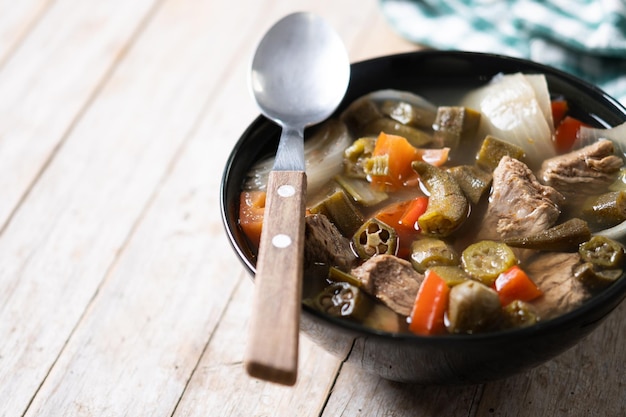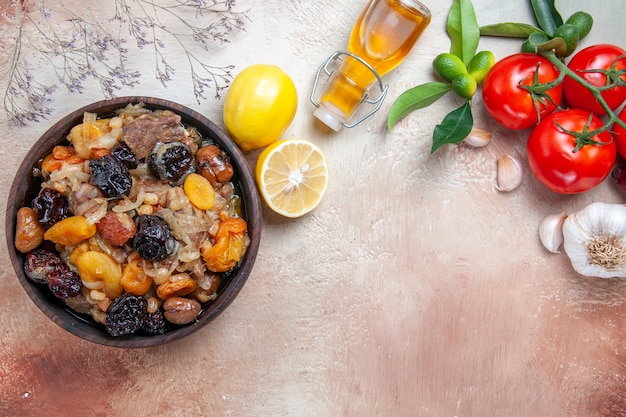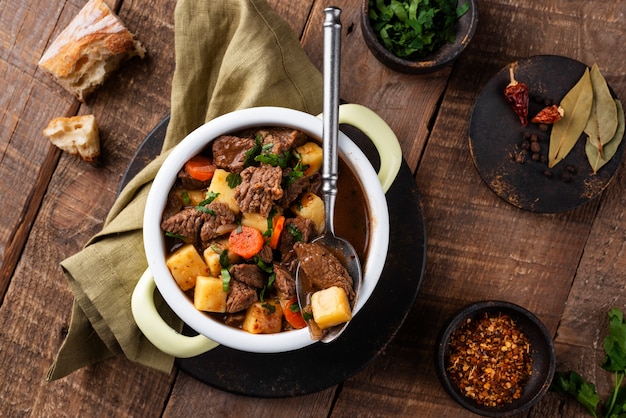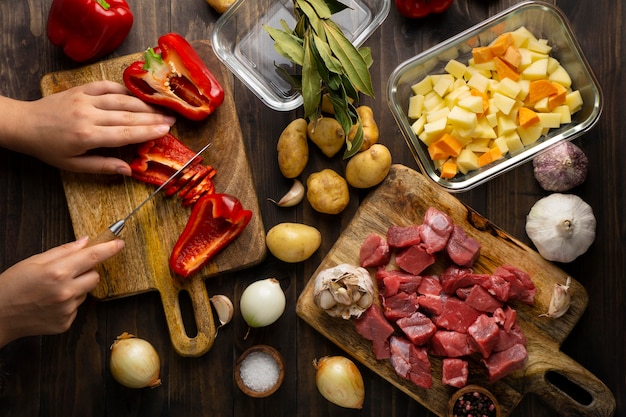Ah, stew meat. Those tough, gnarly chunks of beef that look like they've seen better days. They're often considered a culinary challenge, but trust me, they can be transformed into absolute melt-in-your-mouth deliciousness. As a seasoned cook who's tackled my fair share of stews, I can tell you that with the right technique and a bit of patience, those tough cuts can be turned into culinary masterpieces.This guide will take you on a journey from selecting the perfect cut to mastering the art of slow cooking, guiding you through every step of the process. So, grab a cuppa, settle in, and let's get cooking!
(Part 1) choosing the right cut: The Foundation of Flavor

The first step in making a truly delicious stew is choosing the right cut of meat. You might be thinking, "Stew meat, right? What's the big deal?" But trust me, choosing the right cut makes a world of difference. I've learned this the hard way. Once, I used a lean cut of beef, thinking I'd be saving some fat. Big mistake! It turned out dry and chewy. So, here's the key: you want a cut that's high in collagen, those lovely little protein strands that break down during cooking, creating that mouthwatering tenderness.
Popular Choices for Stew Meat: A Culinary Lineup
- chuck roast: This is my personal favorite. It's a classic for a reason. It's got a good amount of marbling, which gives it lots of flavour.
- Brisket: Brisket is another excellent choice. It's known for its rich flavor and its ability to become super tender with slow cooking.
- short ribs: These are a bit more expensive, but oh my, are they worth it! They're incredibly flavorful and melt in your mouth.
- round steak: This is a leaner option, so you'll need to watch out for dryness. However, it can still be tender with the right cooking method.
When selecting your meat, look for a cut that's marbled. This means it has streaks of fat throughout, which will help keep the meat moist and flavorful during the cooking process. You want that fat to render down, adding richness and depth to your stew.
(Part 2) Preparing the Meat: Unleashing the Flavor

Once you've got your chosen cut, it's time to prepare it. Don't be afraid to get your hands dirty! This is where you can really make a difference in the final flavor.
1. Trim the Fat: A Balancing Act
Trim away excess fat, but don't go overboard. Some fat is good! You want to leave a good layer of fat on the meat, as it will help keep it moist during cooking. Remember, fat equals flavor. Just trim away any excess fat that's not marbling, like large, thick pieces that might not render properly.
2. Cut into Cubes: Mastering the Consistency
Cut the meat into 1-2 inch cubes. This helps ensure even cooking and makes it easier for the flavors to penetrate. If you prefer, you can cut it into larger chunks, but they will take longer to cook.
3. Season and Sear: Building the Flavor Foundation
Here's where things get fun! I love experimenting with different seasonings for my stew meat. My go-to's are salt, pepper, paprika, and garlic powder. You can also add things like onion powder, dried herbs, or even a little bit of cayenne pepper for a kick.
Once seasoned, heat some oil in a dutch oven or a large skillet over medium-high heat. This step is crucial! Searing the meat gives it a beautiful crust and enhances the flavour. Work in batches to avoid overcrowding the pan, which can lead to steaming instead of searing. A good sear creates a caramelized crust that adds depth and complexity to the stew. You want a nice golden brown color on all sides.
(Part 3) Building the Base: A Symphony of Flavors

Now comes the fun part: building the base of your stew. Think of this as the foundation of your flavour masterpiece.
1. Sauteeing Aromatics: The Flavorful Foundation
Once the meat is seared, add some chopped aromatics like onions, carrots, and celery to the pot. Cook them until softened, about 5-7 minutes. This adds a layer of sweetness and complexity to your stew. The aromatics release their flavors and create a base for the stew to build upon. You can also add other aromatics, like garlic, ginger, or shallots, depending on the flavor profile you're aiming for.
2. Adding Flavor: A Culinary Palette
This is where you can really let your creativity shine! Here's what I like to add:
- Tomato Products: Tomato paste and crushed tomatoes add a tangy and rich flavour. Tomato paste, in particular, is a secret weapon for adding depth and richness to stews. The sugar in tomatoes helps balance the acidity and adds a touch of sweetness.
- Wine: A splash of red wine adds a depth of flavour. Choose a wine you'd enjoy drinking. The alcohol cooks off, leaving behind concentrated flavors that enhance the richness of the stew. If you're not a wine drinker, you can substitute beef broth or even water.
- Broth: Beef broth is the obvious choice, but chicken broth or even vegetable broth can work well too. Broth is essential for creating a flavorful base for the stew. The liquid helps the meat to cook evenly and creates a luscious sauce.
- Herbs and Spices: Experiment with different combinations of herbs and spices to create your own unique flavor profile. Herbs and spices are the key to bringing out the unique flavor of your stew. A blend of dried herbs like thyme, rosemary, and bay leaves is a classic combination for beef stew. You can also add other spices like cumin, coriander, or paprika, depending on the flavor profile you're aiming for.
(Part 4) The Art of Slow Cooking: Patience is Key
Here's where the magic happens! This is where patience and time become your best friends. Slow cooking allows the tough cuts of meat to break down and become tender and flavorful.
1. Choosing Your Method: slow cooker, Dutch Oven, or Oven
You've got a few options here:
- Dutch Oven: This is my preferred method. A Dutch oven is heavy and retains heat well, perfect for slow cooking. It's also versatile enough to be used on the stovetop for searing the meat and then transferred to the oven for slow cooking. The tight-fitting lid ensures that the moisture is retained, resulting in a tender and flavorful stew.
- Slow Cooker: A slow cooker is a great option for hands-off cooking. Simply add all the ingredients and let it simmer away. It's perfect for busy weeknights or for those times when you want to set it and forget it. The slow cooker's gentle heat allows the flavors to meld and the meat to become incredibly tender.
- Oven: You can also slow cook your stew in the oven. Cover the pot tightly with foil and bake at a low temperature. This method is especially useful if you don't have a Dutch oven or a slow cooker. The oven's consistent heat ensures that the stew cooks evenly.
2. Setting the Stage: Maintaining the Perfect Simmer
No matter which method you choose, ensure the liquid level is just above the meat and vegetables. The stew should be simmering gently, not boiling. A gentle simmer allows the flavors to develop slowly and the meat to become tender.
3. Time for Patience: A Culinary Transformation
Now, here's the key: slow and low. This is not a race. Let your stew simmer gently for at least 2-3 hours, or even longer for tougher cuts. The longer you cook it, the more tender it will become. The slow cooking process allows the collagen in the meat to break down, transforming it from tough to melt-in-your-mouth tender.
(Part 5) The Finishing Touches: Polishing Your Stew
Once your stew is cooked through, it's time for the finishing touches.
1. Checking for Tenderness: A Test of Success
Use a fork to check if the meat is tender enough. It should fall apart easily. If it's not quite tender yet, continue to cook it for another 30 minutes to an hour.
2. Thicken the Sauce: Achieving the Perfect Consistency
If the sauce is too thin, you can thicken it using cornstarch or flour. Whisk together a tablespoon of cornstarch or flour with two tablespoons of cold water. Then, add it to the stew, stirring constantly until the sauce thickens. A thickened sauce will coat the meat and vegetables, enhancing the flavor and texture of the stew.
3. Add Greens: A Burst of Flavor and Nutrition
Just before serving, add some leafy greens, such as kale or spinach. They'll wilt in the hot sauce and add a lovely bright flavour. Greens add a burst of color and flavor to the stew, and they're a great source of vitamins and minerals.
(Part 6) Serving Your Masterpiece: A Culinary Triumph
And there you have it! Your delicious stew is ready to be served.
1. Garnishes: Adding the Finishing Touches
I like to add a dollop of sour cream or Greek yogurt for a bit of tang. A sprinkle of fresh herbs, like parsley or thyme, also adds a nice touch. Garnishes are a great way to add a visual appeal and a final burst of flavor to the stew. You can also use a drizzle of olive oil or a sprinkle of grated cheese.
2. Accompaniments: Complementing the Stew
Serve your stew with crusty bread, mashed potatoes, or rice. Accompaniments complement the stew and provide a balance of textures and flavors. You can also serve it with a side salad or roasted vegetables.
3. Enjoy! A Culinary Celebration
Remember, cooking is an art, not an exact science. Don't be afraid to experiment and adjust the recipe to your own taste. And most importantly, enjoy the process and the delicious results.
(Part 7) Tips for Success: Elevating Your Stew Game
Here are a few tips I've picked up over the years that I think will really help you nail your stew:
- Don't Overcrowd the Pan: Searing in batches will ensure the meat gets a good crust, not just steamed.
- Deglaze the Pan: Once you've seared the meat, add a splash of wine or broth to the pan and scrape up the browned bits. This adds a ton of flavor to your stew. Deglazing the pan captures the flavorful fond that has been created during the searing process, adding a concentrated burst of flavor to your stew.
- Don't Be Afraid to Adjust Seasonings: Taste your stew as it cooks and add more salt, pepper, or other seasonings as needed. Seasoning is a crucial element in cooking. Taste as you go and adjust accordingly to create the perfect flavor profile for your stew.
- Let It Rest: Once the stew is cooked, let it rest for at least 15 minutes before serving. This allows the flavors to meld and the meat to become even more tender. Resting the stew allows the flavors to distribute evenly and intensifies the overall flavor.
(Part 8) Variations and Creative Ideas: A culinary adventure
Stew is a fantastic blank canvas for creativity. Here are a few ideas to inspire you:
1. International Flavours: A World of Stews
- French: Use red wine, beef broth, and herbs like thyme, rosemary, and bay leaf.
- Italian: Add tomatoes, oregano, basil, and a touch of red pepper flakes.
- Mexican: Use beef broth, cumin, chili powder, and chipotle peppers for a smoky flavour.
- Indian: Add ginger, garlic, turmeric, garam masala, and coconut milk for a spicy and aromatic stew.
2. Beyond Beef: Exploring New Flavors
While beef is a classic for stew, don't be afraid to experiment with other meats like lamb, chicken, or even pork. lamb stew is especially delicious, and chicken stew is a lighter and more delicate option.
3. Vegetarian Options: A Plant-Based Delight
Stew can be a delicious vegetarian dish too! Use hearty vegetables like potatoes, carrots, and lentils, and add a rich broth and flavorful spices. You can also use a combination of different vegetables, like mushrooms, zucchini, and eggplant, to create a truly unique flavor profile.
(Part 9) Troubleshooting: Fixing Common Stew Mishaps
Things don't always go according to plan, right? Here are a few common issues and how to fix them:
1. Stew Is Too Thin: Achieving the Right Consistency
Thickening the sauce is easy. Whisk together cornstarch or flour with cold water and add it to the stew. Stir constantly until the sauce thickens to the desired consistency.
2. Stew Is Too Thick: Adding Some Liquid
Add a little broth or water to thin it out. Start by adding a small amount of liquid and stir until it reaches the desired consistency.
3. Stew Is Too Salty: Balancing the Flavor
Add a little sugar or a pinch of lemon juice to balance the saltiness. Sugar and lemon juice help to cut through the saltiness, making the stew more palatable.
4. Stew Is Too Bland: Adding Some Flavor
Add more salt, pepper, or herbs and spices to boost the flavour. Don't be afraid to experiment with different herbs and spices to find the perfect flavor combination for your stew.
5. Meat Is Tough: Getting It Tender
If the meat is still tough after slow cooking, try cooking it for a little longer. You can also add a bit of acid, like lemon juice or vinegar, to the stew, which can help to break down the tough fibers in the meat.
(Part 10) FAQs: Your Stew Questions Answered
Let's tackle some frequently asked questions.
1. Can I freeze leftover stew?
Absolutely! Leftover stew freezes beautifully. Just cool it completely, transfer it to freezer-safe containers, and label it with the date. It will last in the freezer for up to 3 months. When you're ready to eat it, reheat it on the stovetop or in the microwave.
2. What's the best way to reheat stew?
I recommend reheating it in a pot on the stovetop over low heat. It's also perfectly fine to reheat it in the microwave. Just be sure to stir it occasionally to ensure even heating.
3. What if I don't have a Dutch oven?
You can use a large pot or even a slow cooker to make stew. Just ensure the pot is heavy enough to retain heat evenly. If you're using a slow cooker, you might need to adjust the cooking time, as slow cookers tend to cook at a lower temperature than Dutch ovens.
4. Can I add vegetables to the stew at the beginning?
I wouldn't recommend it. Some vegetables, like carrots and potatoes, take longer to cook than others. Add them during the last hour of cooking so they don't become mushy. Adding vegetables towards the end of the cooking process ensures they retain their texture and flavor.
5. How do I know when the stew is done?
The meat should be tender enough to fall apart with a fork, and the vegetables should be cooked through. Taste the stew and adjust the seasoning as needed. A good stew should be flavorful and well-balanced, with tender meat and cooked-through vegetables.
There you have it, my friends! My ultimate guide to cooking tender and flavorful stew meat. Now, get out there, grab some meat, and start creating your own delicious culinary masterpieces. Happy stewing!
Everyone is watching

Perfect Rice Every Time: The Ultimate Guide to Cooking Rice
Cooking TipsAs a self-proclaimed foodie, I've always been a bit obsessed with rice. It's the foundation of countless cuisi...

Ultimate Guide to Cooking the Perfect Thanksgiving Turkey
Cooking TipsThanksgiving. Just the word conjures up images of overflowing tables laden with delicious food, the scent of r...

The Ultimate Guide to Cooking Asparagus: Tips, Techniques, and Recipes
Cooking TipsAsparagus. The mere mention of this spring delicacy conjures up images of vibrant green spears, crisp and burs...

Can You Cook Spaghetti with Gasoline? (The Shocking Truth)
Cooking TipsWe've all seen those crazy internet trends. You know, the ones that make you wonder, "Did someone actually try...

Chorizo and Eggs Recipe: The Ultimate Guide
Cooking TipsRight, let’s talk about chorizo and eggs. You know, that classic Spanish dish that's always a winner. It's th...
